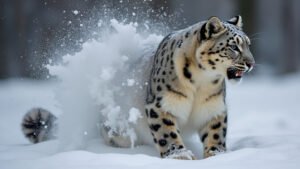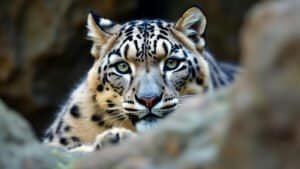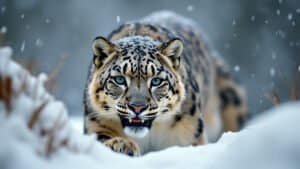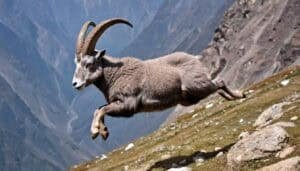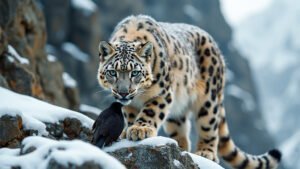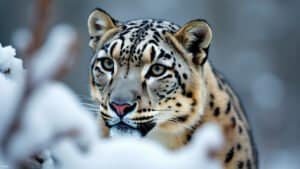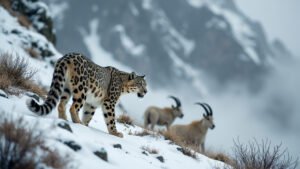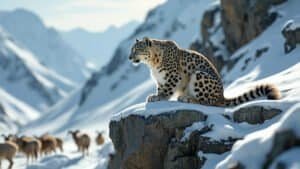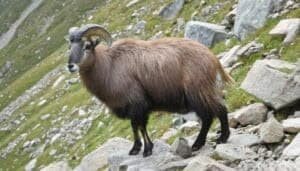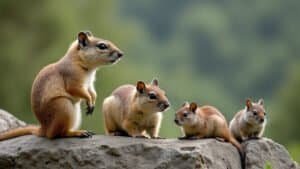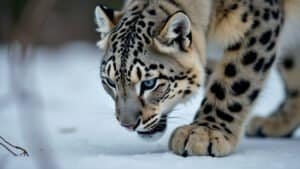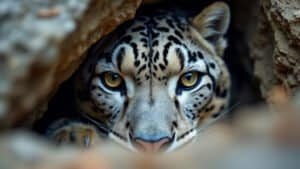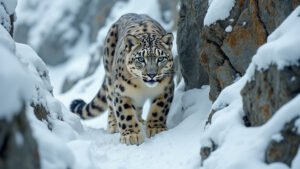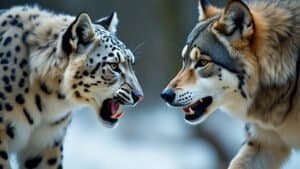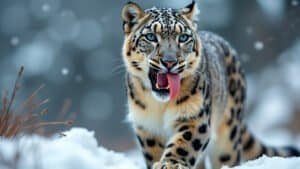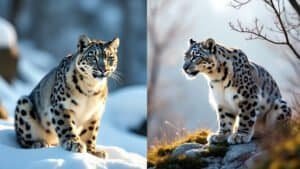Introduction
Snow leopards are elusive and skilled predators. Their hunting techniques are a fascinating blend of stealth, power, and precision, allowing them to thrive in the harsh, mountainous regions they call home
This article delves into the primary diet of snow leopards, how they leverage their environment to their advantage, and the various techniques they employ to hunt successfully. We will also explore the physical adaptations that aid in their hunting prowess, the competition they face from other predators, and how they teach their cubs to become proficient hunters
Understanding these aspects provides a comprehensive insight into the life and survival of this magnificent big cat
The Primary Diet of Snow Leopards
Snow leopards are apex predators with a diet primarily consisting of medium to large-sized prey found in their mountainous habitats. Their dietary preferences are shaped by the availability of prey species, which can vary with the seasons and geographic locations
Understanding their primary diet is crucial to comprehending their hunting behavior and ecological role
Typical Prey Animals
Snow leopards primarily prey on a variety of ungulates, which are hoofed mammals, as well as some smaller mammals and birds
The most common prey includes:
Blue Sheep (Bharal): Blue sheep are a significant part of the snow leopard’s diet, especially in regions like the Himalayas. These animals are well-adapted to rugged terrains, making them a challenging yet rewarding prey for snow leopards
Ibex: Found in the mountains of Central Asia, ibexes are another primary food source. Their agile movements and ability to navigate steep cliffs provide a challenging hunt
Argali: These wild sheep are among the largest prey that snow leopards hunt. Their size and strength require significant effort and strategy to bring down
Marmots and Pikas: In addition to larger prey, snow leopards also hunt smaller mammals such as marmots and pikas, particularly during times when larger prey is scarce
Game Birds: Occasionally, snow leopards will also catch birds such as pheasants and partridges, adding variety to their diet
Seasonal Variations in Diet
The diet of snow leopards can change with the seasons due to the availability of prey and environmental conditions:
Spring and Summer: During these warmer months, the availability of smaller prey like marmots increases as these animals are more active and easier to hunt
Fall and Winter: As snow begins to cover the mountains, snow leopards focus more on larger prey like blue sheep and ibex. These prey animals tend to move to lower elevations, where snow leopards follow to continue their hunt
Migration Patterns: Some prey species migrate seasonally, influencing the movement and hunting patterns of snow leopards. The predators adapt their strategies based on the movement and behavior of their prey
Nutritional Needs
The dietary intake of snow leopards must meet their nutritional needs, which are critical for their survival and reproductive success:
Protein: High-protein content from their prey is essential for muscle development and energy. The lean meat of ungulates provides the necessary protein
Fat: Fat reserves, particularly from larger prey, are crucial for enduring the cold and energy-intensive hunts. Fat helps maintain body heat and sustains energy levels during periods of scarce food availability
Hydration: While snow leopards primarily get their water from the blood and tissues of their prey, they may also consume snow or drink from streams when available
Environmental Advantages in Hunting
Snow leopards possess remarkable adaptations that allow them to excel as hunters in the harsh, rugged environments of the mountainous regions they inhabit
Their ability to utilize the terrain, weather conditions, and natural camouflage gives them a significant edge when stalking and capturing prey
Utilization of Terrain
The mountainous terrain is both a challenge and an advantage for snow leopards. These big cats are highly adapted to navigating steep, rocky slopes and rugged landscapes:
Steep Slopes: Snow leopards use the steep slopes to their advantage by positioning themselves above their prey. This high ground provides them with a strategic vantage point to spot potential prey and plan their attack
Rocky Outcrops: These natural formations offer excellent cover for snow leopards to hide and ambush their prey. Their ability to move silently and remain undetected until the last moment is crucial for a successful hunt
Narrow Passes and Cliffs: By driving prey into narrow passes or towards cliffs, snow leopards can limit the escape routes of their quarry, increasing their chances of a successful capture
Weather Conditions
Snow leopards are well adapted to the cold, harsh weather conditions of their habitats. They can use these conditions to their advantage during hunts:
Snow and Ice: Snow leopards’ thick fur and wide paws allow them to move easily through snow and ice, environments where their prey may struggle. Their light step and silent movement make it difficult for prey to detect them in these conditions
Wind Direction: They often hunt into the wind, which helps carry their scent away from their prey. This minimizes the chance of detection and allows them to get closer before launching an attack
Cold Temperatures: The cold temperatures can slow down their prey, making it easier for snow leopards to catch them. Additionally, prey animals tend to conserve energy and may not flee as quickly in cold conditions
Vegetation and Camouflage
Snow leopards have an exceptional ability to blend into their surroundings, thanks to their natural camouflage and the sparse vegetation of their environment:
Pelage Patterns: The rosette and spot patterns on their fur provide excellent camouflage against the rocky, snowy backdrop of their habitat. This camouflage helps them remain hidden from both prey and potential threats
Sparse Vegetation: The sparse vegetation in their mountainous environment means there are fewer places for prey to hide, giving snow leopards an advantage. They use the available cover, such as rocks and sparse shrubs, to approach their prey stealthily
Coloration: The light gray and white coloration of their fur blends seamlessly with the snowy landscapes, making it challenging for prey to spot them until it is too late
Hunting Techniques of Snow Leopards
Snow leopards employ a variety of sophisticated hunting techniques to capture their prey, relying on their stealth, agility, and strength. These techniques are finely tuned to the challenging environments in which they live, allowing them to successfully hunt and sustain themselves
Stalking Methods
The stalking phase is crucial for snow leopards, allowing them to get as close as possible to their prey before launching an attack:
Slow and Stealthy Approach: Snow leopards are known for their ability to move with extreme caution and silence. They often stalk their prey by staying low to the ground, using rocks and vegetation as cover
Patience: They exhibit tremendous patience, sometimes following their prey for hours before making a move. This careful approach helps them get within striking distance without being detected
Use of Terrain: They take advantage of the terrain to conceal their approach. For instance, they might use ridges or depressions in the landscape to stay out of sight while getting closer to their prey
Ambush Strategies
Once within striking distance, snow leopards employ ambush strategies to surprise their prey, reducing the likelihood of a lengthy chase:
Sudden Pounce: Snow leopards often rely on a sudden, powerful pounce to catch their prey off guard. They use their strong hind legs to leap great distances, closing the gap between themselves and their target quickly
Element of Surprise: The element of surprise is critical. Snow leopards aim to attack from a position where the prey least expects it, often from behind or above
Short Chase: If the initial ambush does not immediately result in a kill, snow leopards can engage in a short chase. However, they are not built for long chases and usually try to overpower their prey quickly
Chase and Capture
The final phase of the hunt involves a brief chase and the actual capture of the prey, where the snow leopard’s physical prowess comes into play:
Speed and Agility: Snow leopards are incredibly fast over short distances. They can reach speeds of up to 40 miles per hour, although they usually rely more on their agility and ability to navigate rocky terrain than on outright speed
Powerful Bite: They use their powerful jaws to deliver a fatal bite to the neck of their prey, often targeting the throat to ensure a quick kill
Securing the Kill: Once the prey is captured, snow leopards use their strong limbs to hold it down while delivering the killing bite. Their large paws and sharp claws help them secure and control struggling prey
Physical Adaptations for Hunting
Snow leopards possess a range of physical adaptations that make them exceptional hunters in the rugged, mountainous regions they inhabit. These adaptations enhance their strength, agility, camouflage, and sensory capabilities, allowing them to excel in their harsh environments
Strength and Agility
The physical prowess of snow leopards is a key factor in their hunting success:
Muscular Build: Snow leopards have a robust and muscular build, particularly in their hind legs, which provides the power needed for their impressive leaps. They can jump up to 50 feet in a single bound, enabling them to cover large distances quickly and catch prey off guard
Flexible Spine: Their flexible spine enhances their agility, allowing them to twist and turn mid-air during a leap. This agility is crucial when navigating the rocky and uneven terrain of their habitats
Large Paws: Their large, padded paws act like natural snowshoes, distributing their weight evenly and preventing them from sinking into the snow. This adaptation not only aids in silent stalking but also in maintaining balance on slippery surfaces
Camouflage and Stealth
The ability to blend into their surroundings and move silently is essential for the snow leopard’s hunting strategy:
Fur Pattern: The rosettes and spots on their fur provide excellent camouflage against the rocky, snowy landscapes. This natural patterning helps them remain undetected by both prey and potential threats
Coloration: Their fur color, a mix of smoky-gray and creamy-white, blends seamlessly with the snowy environment, making it difficult for prey to spot them
Silent Movement: Snow leopards are incredibly stealthy. Their soft, dense fur muffles the sound of their movement, allowing them to approach their prey without making a sound
Sensory Adaptations
Snow leopards rely heavily on their keen senses to locate and hunt their prey:
Acute Vision: Snow leopards have excellent vision, which is essential for spotting prey in the vast, open landscapes they inhabit. They can see clearly in low light conditions, allowing them to hunt at dawn or dusk when their prey is most active
Sharp Hearing: Their acute hearing enables them to detect the slightest sounds, such as the movement of prey or the presence of potential threats. This heightened sense of hearing is particularly useful in the often silent, snowy environments
Sense of Smell: Although not as reliant on their sense of smell as some other predators, snow leopards use it to detect prey and mark their territory. This sense helps them identify the presence of prey animals in their vicinity
Competition and Survival
In the harsh environments where snow leopards live, competition for resources is intense. Understanding how snow leopards handle competition from other predators and their survival strategies provides insight into their resilience and adaptability
Competing Predators
Snow leopards share their habitats with several other predators, leading to competition for the same prey:
Wolves: In some regions, wolves compete with snow leopards for ungulate prey such as blue sheep and ibex. Wolves hunt in packs, which can pose a significant challenge to solitary snow leopards
Brown Bears: Brown bears, though primarily omnivores, may compete with snow leopards for large prey during certain seasons. Their size and strength can give them an advantage in direct encounters
Lynxes: Although smaller than snow leopards, lynxes also hunt smaller mammals and birds, overlapping in prey preferences with snow leopards
Humans: Human activities, including hunting and habitat encroachment, pose significant threats. Livestock herding leads to retaliatory killings by herders when snow leopards prey on domestic animals
Territorial Behavior
Snow leopards maintain large territories to ensure they have sufficient prey and resources for survival:
Territory Marking: They use scent marking, scraping, and vocalizations to define and defend their territories. These markers help reduce direct conflicts with other snow leopards by delineating boundaries
Solitary Nature: As solitary animals, snow leopards avoid direct competition by spacing themselves out across vast areas. This reduces encounters with other predators and minimizes the risk of injury
Resource Management: By carefully managing their territories, snow leopards ensure a steady supply of prey. They may adjust their territories seasonally based on prey availability and environmental conditions
Success Rates of Hunts
The hunting success rate of snow leopards is a critical factor in their survival, reflecting their efficiency and adaptability:
Success Rate: Studies suggest that snow leopards have a hunting success rate of around 10-20%. This means they must attempt multiple hunts to secure a meal, highlighting the difficulty of their environment
Energy Conservation: Snow leopards balance their energy expenditure with their hunting efforts. They are known to rest for several days after a successful hunt to conserve energy
Prey Utilization: They make efficient use of their kills, often consuming every edible part. They may also cache leftovers to return to later, ensuring they maximize the nutritional value of each hunt
Teaching the Next Generation
The survival of snow leopards depends not only on their hunting prowess but also on their ability to pass these skills to their offspring
Teaching the next generation involves a combination of direct instruction and observational learning, ensuring that cubs develop the necessary skills to thrive in their challenging environment
Cub Training Methods
Mother snow leopards play a crucial role in training their cubs to become proficient hunters:
Early Lessons: Training begins when cubs are around two to three months old. Mothers start by introducing cubs to solid food through small prey they have caught
Observation: Cubs learn by observing their mother’s hunting techniques. They watch how she stalks, ambushes, and captures prey, gradually understanding the intricacies of each step
Practice Hunts: As cubs grow older, mothers encourage them to practice hunting. They may start with smaller, easier-to-catch animals like rodents or birds before progressing to larger prey
Play Behavior: Play is an essential part of cub training. Through play, cubs develop their physical skills, such as pouncing, chasing, and wrestling, which are vital for successful hunting
Learning Through Observation
Observation is a key component of how snow leopard cubs learn to hunt effectively:
Silent Observation: Cubs often accompany their mother on hunts, remaining silent and hidden while she stalks prey. This firsthand experience allows them to learn the timing and precision required for a successful hunt
Mimicking Behavior: Cubs imitate their mother’s actions, from the way she moves silently to how she positions herself for an ambush. This mimicry helps them internalize effective hunting strategies
Gradual Independence: As cubs grow and gain confidence, they start to venture out on their own, practicing what they have learned. The mother gradually reduces her involvement, encouraging independence
Mother-Cub Hunting Partnerships
In the early stages, mother and cubs may hunt together, forming a cooperative partnership that benefits the learning process:
Shared Hunts: During shared hunts, the mother may intentionally injure prey without killing it, allowing cubs to practice the final stages of the hunt. This hands-on experience is critical for developing their skills
Protective Role: The mother also plays a protective role, ensuring cubs are safe from other predators and environmental hazards while they learn
Gradual Weaning: As cubs become more skilled, the mother begins to wean them off her support. By the time they are around 18 to 24 months old, cubs are typically ready to survive and hunt on their own
Conclusion
Snow leopards are extraordinary predators, uniquely adapted to the harsh, mountainous regions they inhabit. Their diet mainly consists of medium to large-sized ungulates, which they hunt using a blend of stealth, power, and strategic ambush techniques
Leveraging their environment, from the rocky terrain to the cold, snowy conditions, snow leopards maximize their hunting success. Their physical adaptations, such as powerful legs, keen senses, and camouflaged fur, further enhance their hunting efficiency
Competition with other predators and the necessity to teach their cubs critical survival skills add to the complexity of their lives. Understanding these aspects of snow leopard behavior and ecology is crucial for conservation efforts and ensuring the survival of this majestic species in their natural habitat


